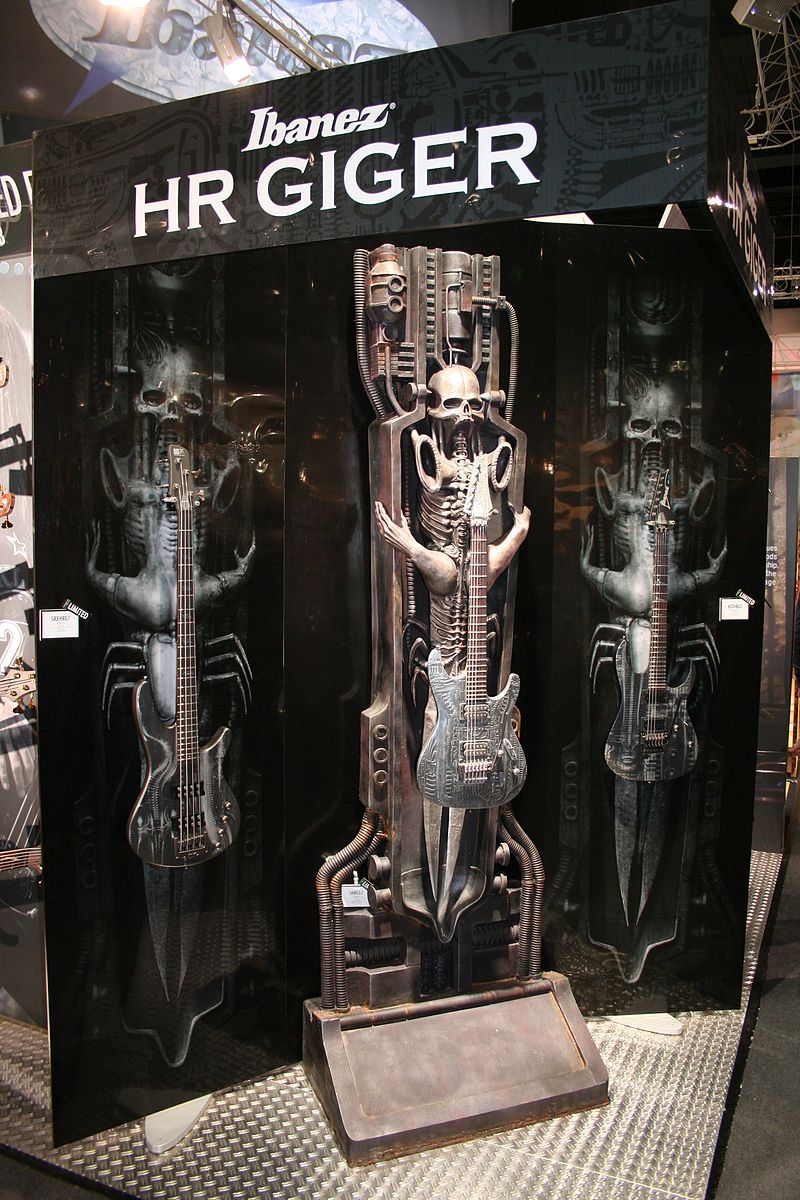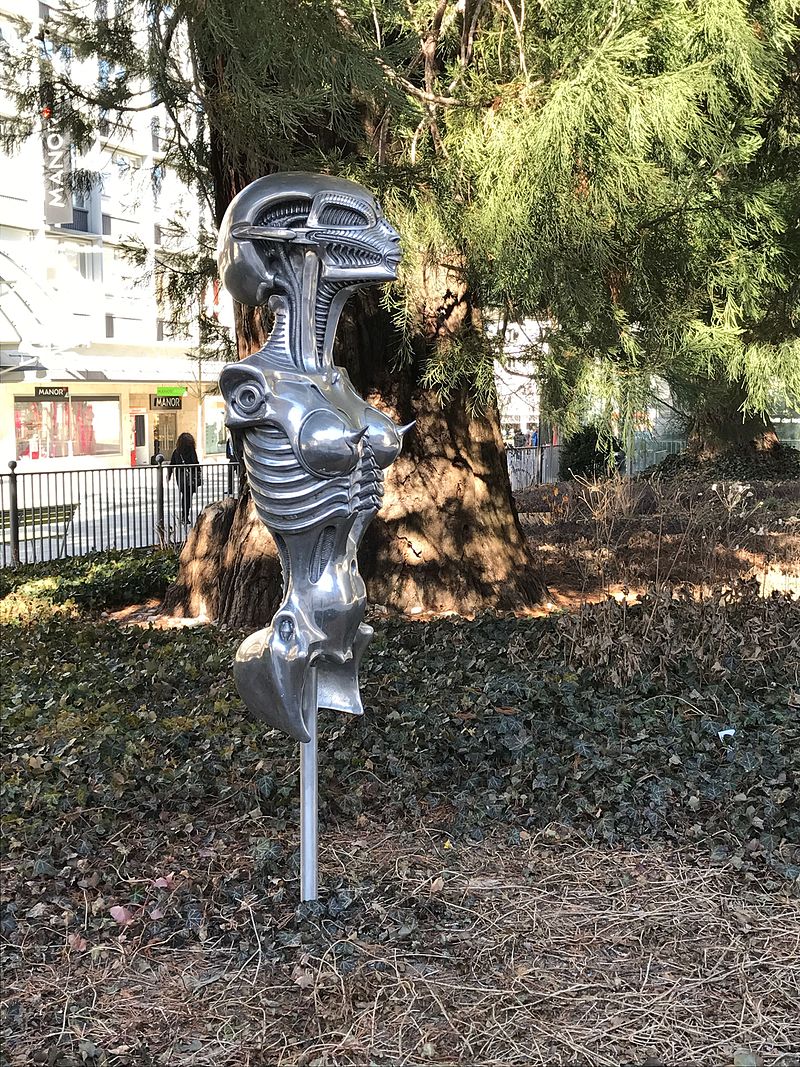Hans Ruedi Giger (Chur, Graubünden, Switzerland, 5 February 1940 – Zürich, Switzerland, 12
May 2014) was a Swiss painter, whose style was adapted for many forms
of media, including record albums, furniture and tattoos.
The Zurich-based artist was best known for airbrush images of humans
and machines linked together in a cold 'biomechanical' relationship.
Later he abandoned airbrush work for pastels, markers, and ink. He was
part of the special effects team that won an Academy Award for design work on the film Alien.
In Switzerland there are two theme bars that reflect his interior
designs, and his work is on permanent display at the H.R. Giger Museum
at Gruyères.
Early life
Giger was born in 1940 in Chur, capital city of Graubünden, the largest and easternmost Swiss canton. His father, a pharmacist, viewed art as a "breadless profession" and strongly encouraged him to enter pharmacy, Giger recalled. He moved to Zürich in 1962, where he studied architecture and industrial design at the School of Applied Arts until 1970.
Career
Giger's first success was when H. H. Kunz, co-owner of Switzerland's
first poster publishing company, printed and distributed Giger's first
posters, beginning in 1969.
Giger's style and thematic execution were influential. He was part of the special effects team that won an Academy Award for Best Achievement in Visual Effects for their design work on the film Alien. His design for the Alien was inspired by his painting Necronom IV and earned him an Oscar in 1980. His books of paintings, particularly Necronomicon and Necronomicon II (1985) and the frequent appearance of his art in Omni magazine continued his rise to international prominence. Giger was admitted to the Science Fiction and Fantasy Hall of Fame in 2013. He is also well known for artwork on several music recording albums including Danzig III: How The Gods Kill by Danzig, Brain Salad Surgery by Emerson, Lake & Palmer and Deborah Harry's KooKoo.
In 1998, Giger acquired the Château St. Germain in Gruyères, Switzerland, and it now houses the H.R. Giger Museum, a permanent repository of his work.
Personal life
Giger had a relationship with Swiss actress Li Tobler
until she committed suicide in 1975. Li's image appears in many of his
paintings. He married Mia Bonzanigo in 1979; they divorced a year and a
half later.
The artist lived and worked in Zürich with his second wife, Carmen
Maria Scheifele Giger, who is the Director of the H.R. Giger Museum.
Death
On 12 May 2014, Giger died in a hospital in Zürich after having suffered injuries in a fall.
Birth Machine sculpture in Gruyères
Style
Giger started with small ink drawings before progressing to oil
paintings. For most of his career, Giger had worked predominantly in airbrush, creating monochromatic canvasses depicting surreal, nightmarish dreamscapes. However, he then largely abandoned large airbrush works in favor of works with pastels, markers or ink.
Giger's most distinctive stylistic innovation was that of a representation of human bodies and machines in a cold, interconnected relationship, he described as "biomechanical". His main influences were painters Dado, Ernst Fuchs and Salvador Dalí. He met Salvador Dalí, to whom he was introduced by painter Robert Venosa. Giger was also influenced by the work of the sculptor Stanislas Szukalski, and by the painters Austin Osman Spare and Mati Klarwein. He was also a personal friend of Timothy Leary.
Giger studied interior and industrial design at the School of
Commercial Art in Zurich (from 1962 to 1965) and made his first
paintings as a means of art therapy.
Other works
Ibanez H. R. Giger signature bass and guitars
Other works
Giger directed a number of films, including Swiss Made (1968), Tagtraum (1973), Giger's Necronomicon (1975) and Giger's Alien (1979).
Giger created furniture designs, particularly the Harkonnen Capo Chair for a film of the novel Dune that was to be directed by Alejandro Jodorowsky. Many years later, David Lynch
directed the film, using only rough concepts by Giger. Giger had wished
to work with Lynch, as he stated in one of his books that Lynch's film Eraserhead was closer than even Giger's own films to realizing his vision.
Giger applied his biomechanical style to interior design. One "Giger Bar"
appeared in Tokyo, but the realization of his designs was a great
disappointment to him, since the Japanese organization behind the
venture did not wait for his final designs, and instead used Giger's
rough preliminary sketches. For that reason Giger disowned the Tokyo
bar. The two Giger Bars in his native Switzerland, in Gruyères and
Chur, were built under Giger's close supervision and they accurately
reflect his original concepts. At The Limelight
in Manhattan, Giger's artwork was licensed to decorate the VIP room,
the uppermost chapel of the landmarked church, but it was never intended
to be a permanent installation and bore no similarity to the bars in
Switzerland. The arrangement was terminated after two years when the
Limelight closed. As of 2009 only the two authentic Swiss Giger Bars
remain.
Giger's art has greatly influenced tattooists and fetishists worldwide. Under a licensing deal Ibanez guitars released an H. R. Giger signature series: the Ibanez ICHRG2, an Ibanez Iceman,
features "NY City VI", the Ibanez RGTHRG1 has "NY City XI" printed on
it, the S Series SHRG1Z has a metal-coated engraving of "Biomechanical
Matrix" on it, and a 4-string SRX bass, SRXHRG1, has "N.Y. City X" on
it.
Giger is often referred to in popular culture, especially in science
fiction and cyberpunk. William Gibson (who wrote an early script for Alien 3) seems particularly fascinated: A minor character in Virtual Light, Lowell, is described as having New York XXIV tattooed across his back, and in Idoru a secondary character, Yamazaki, describes the buildings of nanotech Japan as Giger-esque.
Films
Weiblicher Torso von HR Giger, 2009 im Garten des Bündner Kunstmuseums
Films
- Dune (designs for unproduced Alejandro Jodorowsky adaptation of the Frank Herbert novel; the movie Dune was later made in an adaptation by David Lynch)
- Alien (designed, among other things, the Alien creature, "The Derelict" and the "Space Jockey")
- Aliens (credited for the creation of the creature only)
- Alien 3 (designed the dog-like Alien bodyshape, plus a number of unused concepts, many mentioned on the special features disc of Alien 3, despite not being credited in the movie theater version)
- Alien Resurrection (credited for the creation of the creature only)
- Poltergeist II: The Other Side
- Killer Condom (creative consultant, set design)
- Species (designed Sil, and the Ghost Train in a dream sequence)
- Batman Forever (designed radically different envisioning of the Batmobile; design was not used in the film)
- Future-Kill (designed artwork for the movie poster)
- Tokyo: The Last Megalopolis (creature designs)
- Prometheus (the film includes "The Derelict" spacecraft and the "Space Jockey" designs from the first Alien film, as well as a "Temple" design from the failed Jodorowsky Dune project and original extraterrestrial murals created exclusively for Prometheus, based in conceptual art from Alien. Unlike Alien Resurrection, the Prometheus film credited H. R. Giger with the original designs).
in Wikipédia







Sem comentários:
Enviar um comentário